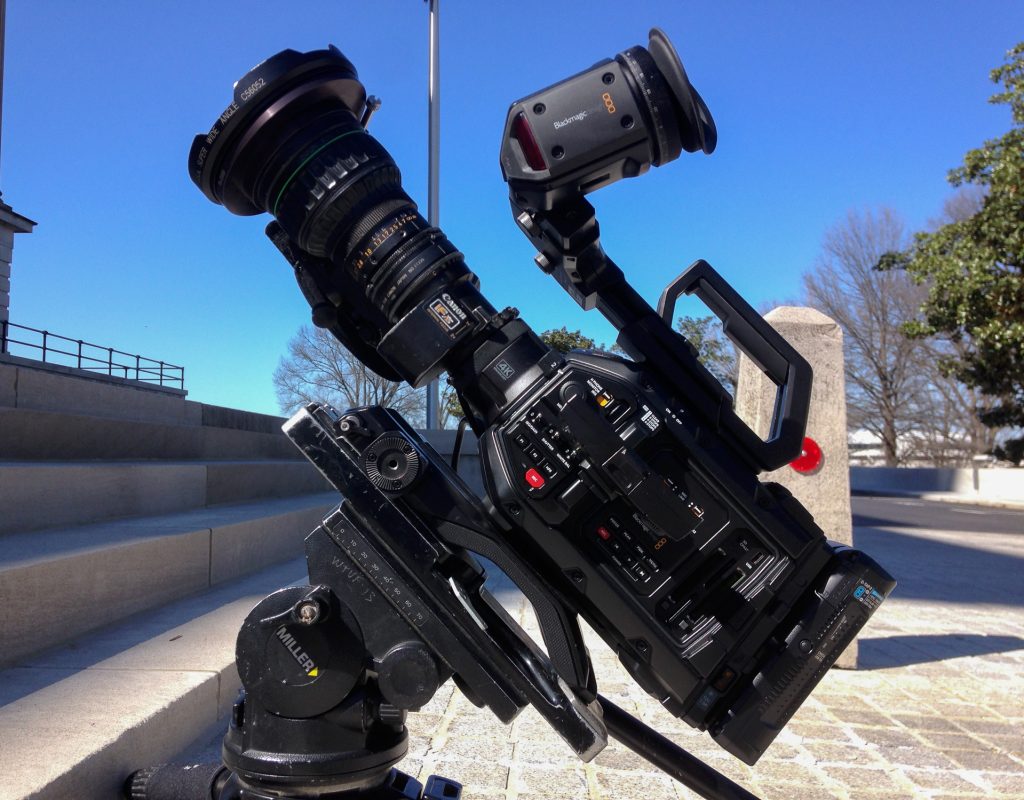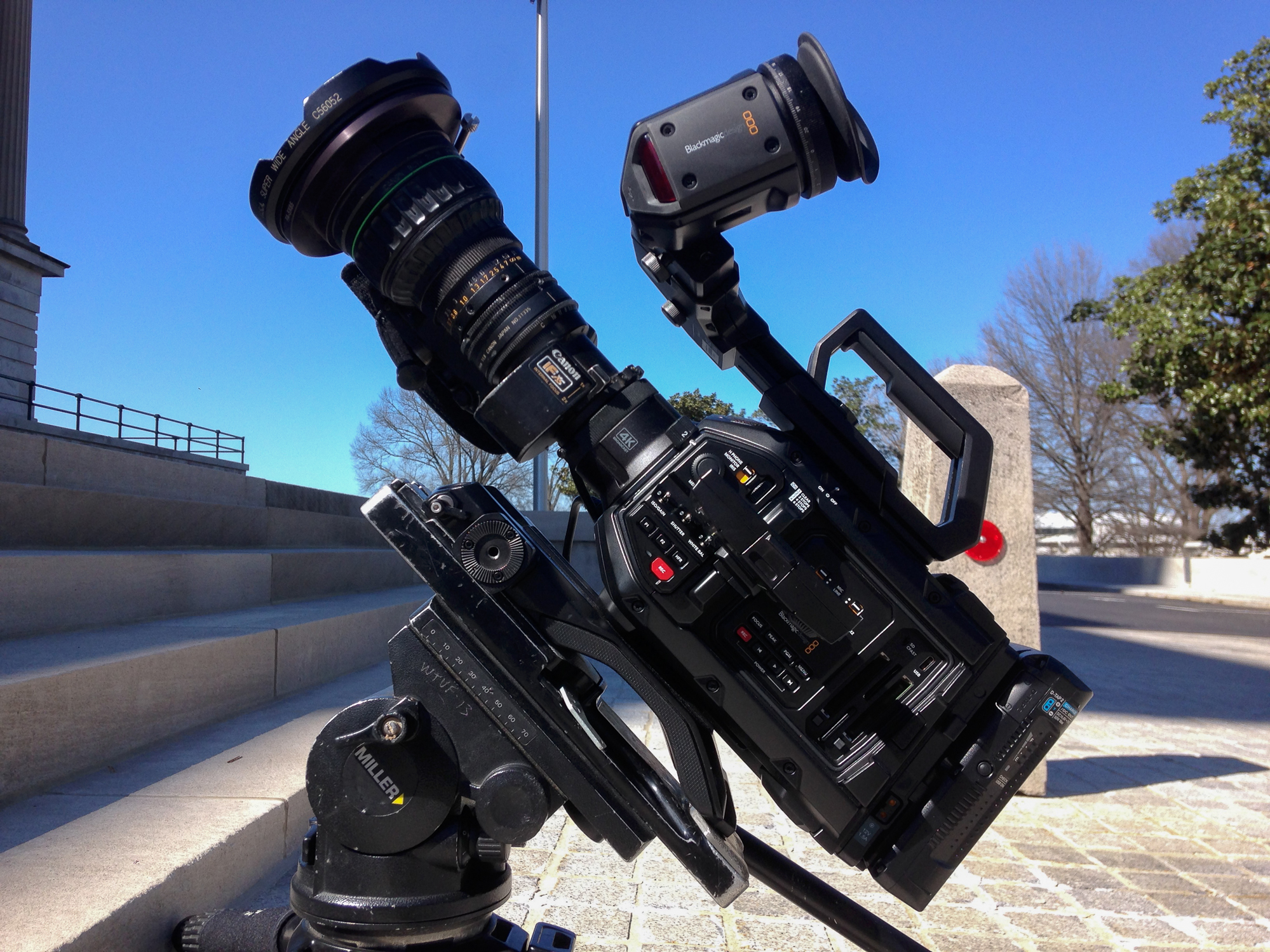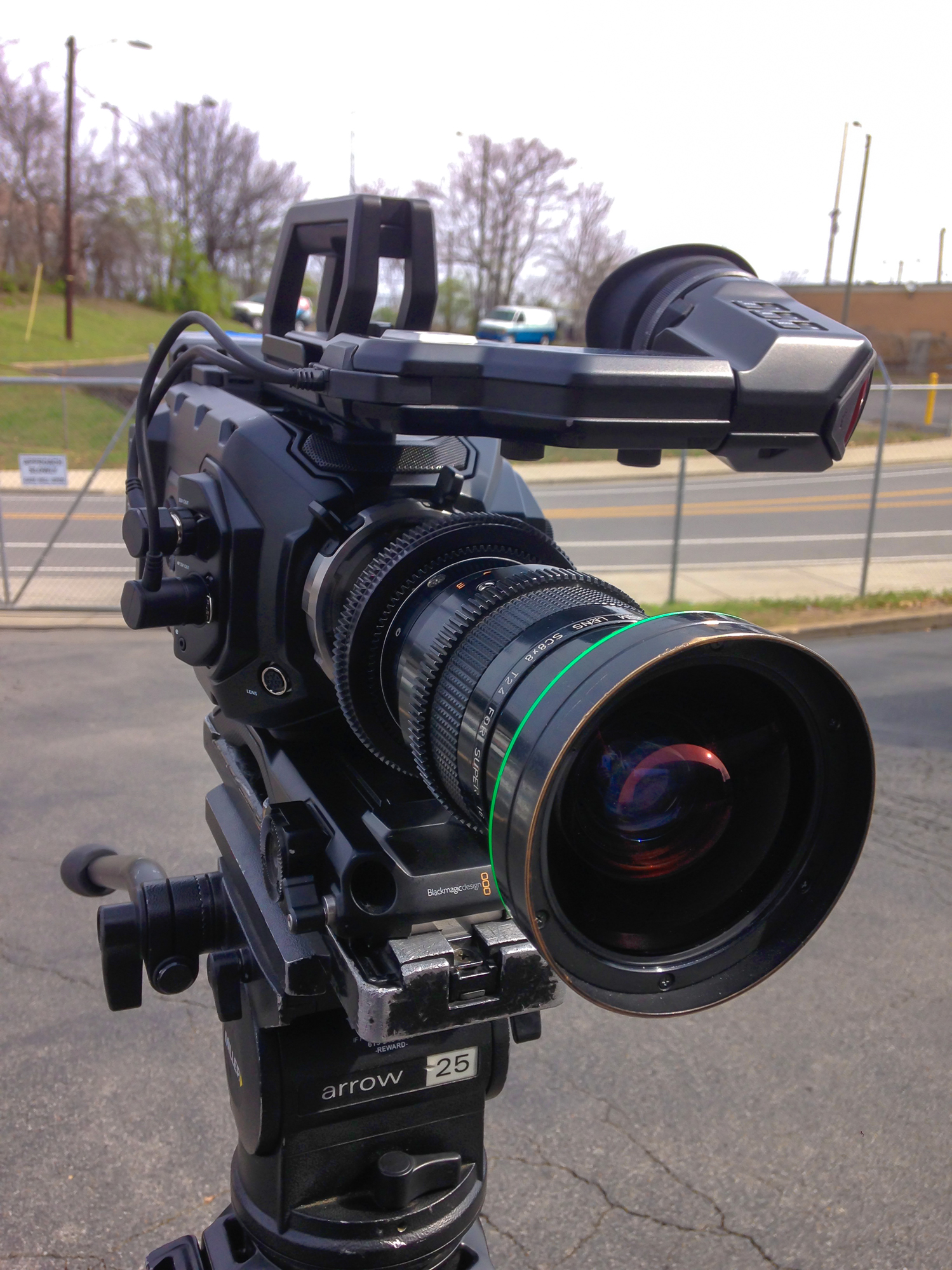When every other manufacturer went with a larger Full-Frame sensor in their flagship cameras Blackmagic decided to go in a wholly different direction with the smaller sized sensor URSA Broadcast. They released a camera aimed right at the DSLR shooter who is maybe a little tired of chasing focus. A camera designed for a broadcast studio as well as designed to work well in the field. Utilizing the well-made URSA Mini Pro body, the URSA Broadcast is one robust production camera capable of shooting your highest production value with its raw and 12-bit color recording capabilities which are usually features found nowhere near the normal B4 lensed production camera. I shot news coverage with the camera to show an example of the footage but in no way does the tv station I shot for promote cameras or even does camera reviews. This review is just my thoughts and experiences with the URSA Broadcast.
URSA Broadcast
What is this camera? It is a production camera meant to fill in nicely with Blackmagic Design’s production tools already on the market, in churches, schools, and many different production facilities. For those who find themselves shooting just as much in a studio with multiple cameras as well as outside, on location, then I think Blackmagic designed this camera with you in mind.
B4 Lenses
If you have been a sports or news photographer, maybe even a nature photographer, then you have likely experienced the benefit of the B4 lens. This lens is all about flexibility and boy does this style lens have it. From wide to telephoto with the press of a single zoom button. A B4 lens, I feel like, was designed so a cameraperson would not miss the shot because of changing lenses. While the lens itself may make a few compromises these lenses do have plenty of benefits to offset them. First, a used HD B4 lens can be very reasonably priced. Second, most B4 lenses have an open aperture near F1.8. Third, a built-in doubler is usually built into the lens.
Electronic News Gathering Camera?
Everything about this camera screams news camera. From the detail settings in the menu to the optional interlaced options this camera will feel very familiar to news shooters. Yet, the URSA Broadcast will also feel just a bit off too. For example, with a fully built URSA Broadcast (Shoulder kit, EVF, and Battery) I found the camera was a little off balance and front heavy and this is the camera pushed all the way back on its Shoulder Kit. I think if I had to shoot with this camera every day I may add the SSD recorder just to help balance the camera on my shoulder a little better.
The Avid DNxHD 220x and 145 are your interlaced shooting options but I have yet to run into a newsroom who actually uses Avid codecs. They usually use whatever barely broadcast capable (i.e. lowest setting) because shared storage, like Avid’s, can be costly. But, I also now places who will love to shoot DNxHD 220x or Pro Res 4444 but they tend to be smaller production facilities than larger beehives like a local tv newsroom.
The 4K Image
This is not a noise-free camera. Yes, in the lower db, gain, or ISO it’s really whatever you want to name it, the image is nice with a little bit more sharpness than found in the URSA Mini Pro. In the highest gain setting the noise is apparent and the shadows have a little bit of the tell-tale Blackmagic Design fixed noise pattern though it is much less than their other cameras. The color is straight up Blackmagic and can be very appealing. Skin tones looked well balanced without too much red or yellow in the color.
What is missing is a Black Balance setting in the menu. I say this because if you are setting up a three camera shoot and are pressed for time then trying to match cameras can become an afterthought. If you can Black Balance all three cameras as well as White Balance then you tend to get the three to match pretty well. Also, in the review, URSA Broadcast Blackmagic Design sent me I found the shadows and blacks had a touch of color, like amber, in the image. This, of course, could be operator error too.
ATEM Production World
If you are using Blackmagic Design’s ATEM switchers and other live equipment then a director can color the cameras to match with DaVinci Resolve Live. The Live Production world is where I think the URSA Broadcast was designed to shine.
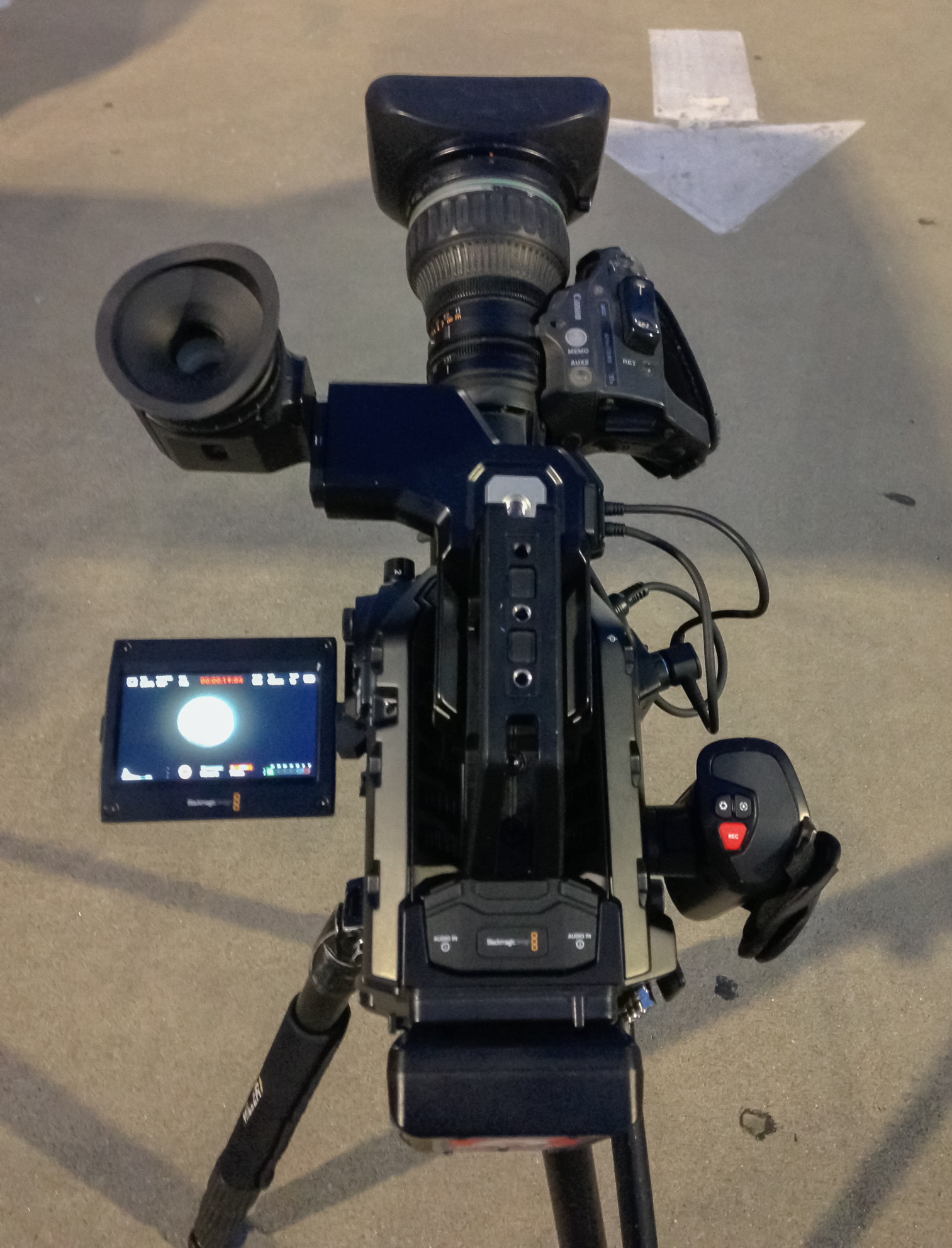 Dynamic Range
Dynamic Range
The URSA Broadcast has a stated 12 Stops of Dynamic range. When I shot raw I found the dynamic range felt very close to 12 Stops, but of course, I was not scientific at all with my tests. My opinion is based on instinct and gut reaction. With that being said I don’t think the straight video codecs are giving us 12 stops of dynamic range and I think Blackmagic tried to solve this issue by releasing this camera with three looks: Video, Extended Video, and Film. Obviously, the Film look will give a shooter the most dynamic range without shooting raw, but I kind of have a feeling that shooters are going to favor the easier to shoot and color grade Extended Video look.
Secret Hidden Camera
Just forget everything I just wrote about the URSA Broadcast camera. This is not the real camera Blackmagic Design released into the wild. Nope. The Blackmagic URSA Broadcast a straight up 4K Super 16mm digital film camera. How do I know? Because I have Contrast Visuals and Consulting nearby and their cache of lenses to test. One of their very first lenses was a vintage Canon 8-64mm Super 16mm lens. When you take off the abhorrent B4 light sucking lens mount off and add a PL lens mount this camera comes alive. I am dead serious. The camera is more light sensitive and the image seemed a little clearer, could be a placebo effect, I found the look turned out to be a little nicer, a little softer, and a little more pleasing.
Call me crazy but I might be more likely to shoot with a forty-year-old Canon 8-64mm lens then a B4 lens. I just like it way more. As I think about it, the camera, fully assembled, was a little lighter and closer to the URSA Mini Pro I love so much. My first music videos were shot on Super 16mm and the format and its look feel a little bit more at home for me visually.
What about lens imperfections? What about purple fringing? In my quick tests, I did not see any issue with a less than perfect lens on the URSA Mini Pro. It could be for a few reasons. The lens is well made, well cared for, and has remained in pristine shape. I did not have a lighting situation where I could better see purple fringing.
Global Shutter
While shooting an S16mm zoom lens I found the camera has a global shutter. Yes, the old whip pan back and forth test never really fails does it. Anyway, from what I can tell there is not much information about the URSA Broadcast having a global shutter on any of Blackmagic Designs’ websites or information. To me, a global shutter camera still is kind of a big deal. It is an especially a big deal for those who shoot sports of nature photography.
Shooting News
I took this camera out and actually shot news stories on it. I might not have shot the whole story with the URSA Broadcast because I had a different camera the station wants me to shoot on and their entire system is all set up for this camera and its codec, but I reserved the URSA Broadcast for my broll if I could. I found the larger sensor provided a little less depth of field than a 2/3 inch sensor and the colors looked nice right out of the camera. For me, this is a good news camera if you are not faced with challenging dark late night shooting situations.
Overall Thoughts
For a broadcast camera, the URSA Broadcast fits the bill well. For a studio camera, again the URSA Broadcast and its integrated features that work with the ATEM switcher fits the bill well. I can see quite a few smaller production teams adopting this camera along with the rest of Blackmagic’s live production catalog. I wish the camera was a little more light sensitive and the noise in the higher ISOs was a little less apparent. The color and the look of this camera is good though. I expect to use it often for my broadcast clients.
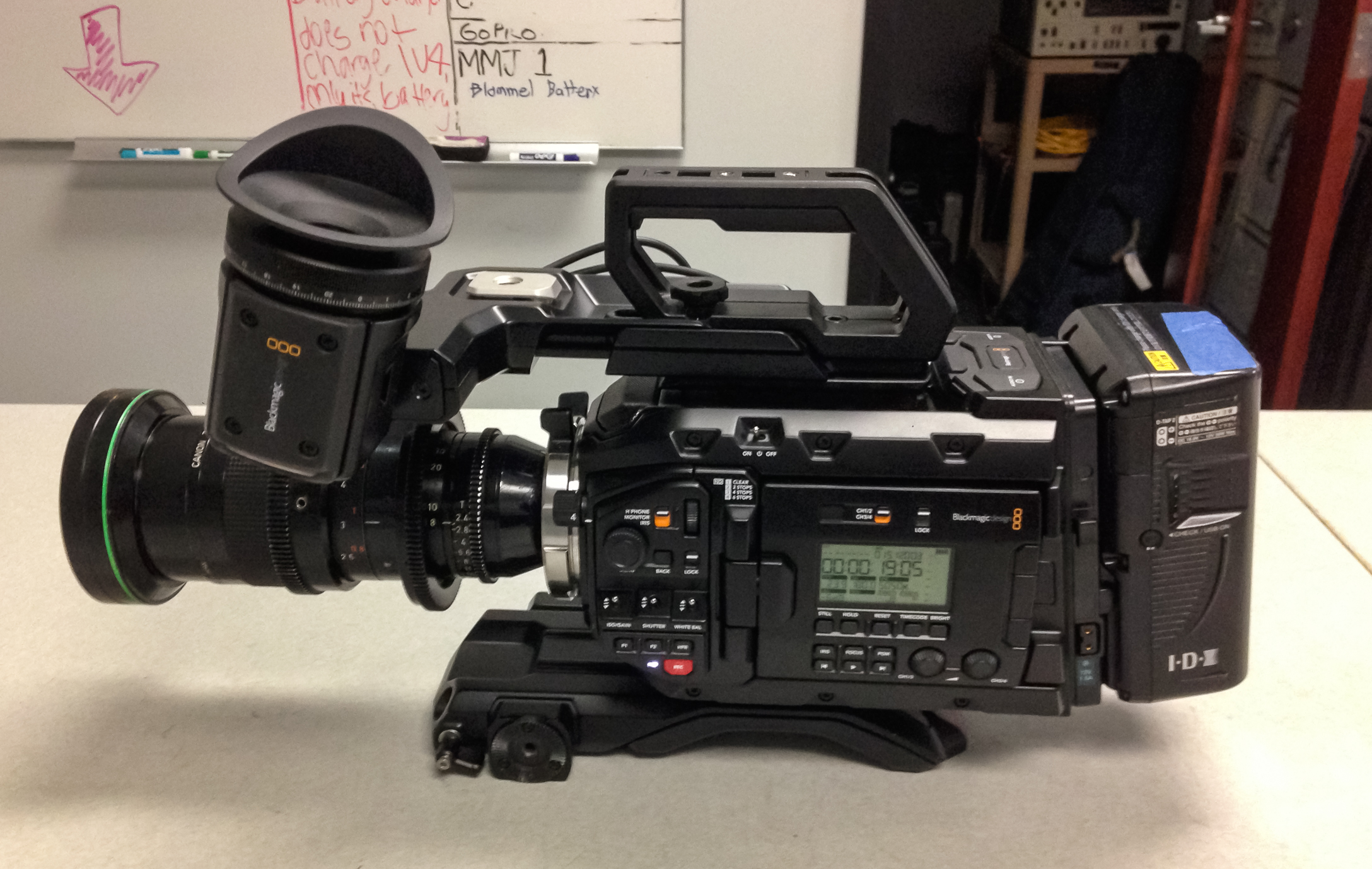
Blackmagic URSA Broadcast Key Features
- 4K sensor, extended video dynamic range, traditional external controls and buttons, built in optical ND filters, dual CFast and dual SD card recorders,
- Advanced HD and Ultra HD broadcast camera with ⅔” B4 mount.
- New extended video mode with better dynamic range and color fidelity producing images with amazing texture and detail, accurate skin tones, vibrant color and high dynamic range.
- Full electronic B4 lens control support for adjusting focus, iris, and zoom using the camera’s controls, or remotely from an ATEM switcher or ATEM Camera Control Panel.
- Built-in dual SD/UHS-II and CFast card recorders allow unlimited duration recording in high quality.
- Records 1080i or 2160p video into standard .mov files using DNx145, DNx220X or ProRes for compatibility with existing broadcast systems and workflows. Standard .mxf will be added in future updates.
- Support for DNxHD 220X, DNxHD 145, Apple ProRes 4444 XQ QuickTime, ProRes 4444 QuickTime, ProRes 422 HQ QuickTime, ProRes 422 QuickTime, ProRes 422 LT QuickTime and ProRes 422 Proxy QuickTime, CinemaDNG RAW, CinemaDNG RAW 3:1, CinemaDNG RAW 4:1.
- High quality clear, 1/4, 1/16th and 1/64th stop neutral density (ND) filters with IR compensation designed to specifically match the colorimetry and color science of URSA Broadcast.
- Fully redundant controls including external broadcast controls which allow direct access to the most important camera settings such as external power switch, ND filter wheel, ISO, shutter, white balance, record button, audio gain controls, lens and transport control, high frame rate button and more.
- Interchangeable lens mount with B4 mount included as standard. Optional EF, PL and F mount available separately.
- Status display for quickly checking timecode, shutter and lens settings, battery, recording status, and audio levels.
- Features all standard connections, including dual XLR mic/line audio inputs with phantom power, 12G‑SDI output for monitoring with camera status graphic overlay and separate XLR 4 pin power output for viewfinder power, headphone jack, LANC remote control and standard 4 pin 12V DC power connection.
- Built-in high-quality stereo microphones for recording sound.
- 4-inch foldout touchscreen for on-set monitoring and menu settings.
- Blackmagic SDI Control Protocol for external control or iPad control via Bluetooth®, 2 x 2.5mm LANC for lens and record control.
Availability and Price
Blackmagic URSA Broadcast is available now from Blackmagic Design resellers worldwide for US$3,495.
Blackmagic URSA Broadcast Accessories
- Blackmagic Camera Fiber Converter.
- Blackmagic Studio Fiber Converter.
- ATEM Camera Control Panel (available May/June 2018).
- Blackmagic URSA Broadcast Shoulder Kit features built-in rosettes, rail mounts, viewfinder mount, integrated tripod quick lock release and top handle.
- Blackmagic URSA Viewfinder is a high-resolution viewfinder that includes a full HD OLED display and true glass optics for perfect focus.
- Blackmagic URSA Studio Viewfinder featuring 7” screen, variable tension mounting points, easy grip handles, external controls and more.
- URSA VLock Battery Plate provides a VLock compatible plate for attaching third-party batteries.
- Interchangeable EF, F and PL lens mounts.

Filmtools
Filmmakers go-to destination for pre-production, production & post production equipment!
Shop Now